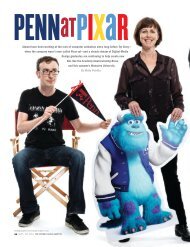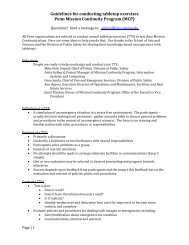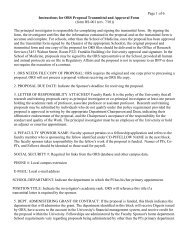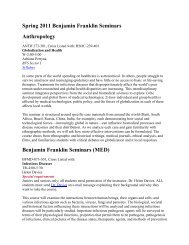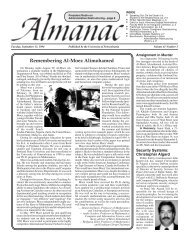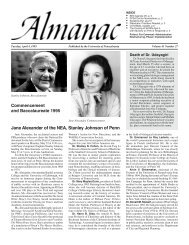Download this article (PDF) - University of Pennsylvania
Download this article (PDF) - University of Pennsylvania
Download this article (PDF) - University of Pennsylvania
You also want an ePaper? Increase the reach of your titles
YUMPU automatically turns print PDFs into web optimized ePapers that Google loves.
“We had to come up with something totally different,”<br />
explains Pattison, who wrote a four-page outline around that<br />
time describing their vision for what had now become the<br />
four sections <strong>of</strong> the memorial: the Room and the Statue, the<br />
Garden, the House <strong>of</strong> the Garden, and the Grove. All the amenities<br />
that had been planned for the Bastion were to be moved to<br />
the House—a sort <strong>of</strong> underground reception space and arcade<br />
with an “immense glass façade” and an “intimate, exuberant<br />
‘Rose Garden’” above the arcade. The Grove, which also went<br />
through numerous iterations before being scrapped, would<br />
have been at the north end <strong>of</strong> the park, forming an interface<br />
with the Renwick Ruin.<br />
The idea “definitely was theater,” she says. “And it was a<br />
narrative. I wanted people to come and have a journey through<br />
the American continent, through <strong>this</strong> mystery.” When you<br />
arrived at the top <strong>of</strong> the stairs, you wouldn’t “see Last Year at<br />
Marienbad or Kaiser Wilhelm on a horse, but you saw a village<br />
green that was very American.” And, in the distance, “you just<br />
see the head <strong>of</strong> Roosevelt, the way you’d see him on a coin, the<br />
way we knew him—disembodied—on the radio broadcasts.”<br />
William Walton, the chair <strong>of</strong> the Washington Fine Arts<br />
Commission who had originally recommended Kahn for the<br />
project, was the one who suggested using the bronze head <strong>of</strong><br />
FDR created by sculptor Jo Davidson, a contemporary <strong>of</strong> the<br />
president’s, Pattison notes. “But it was Lou’s idea to enlarge<br />
it, to play with scale and put it in a niche—welcoming people,<br />
welcoming new arrivals. Just an intimate, individual kind <strong>of</strong><br />
greeting—but then you wanted to get beyond that to <strong>this</strong> sort<br />
<strong>of</strong> mystery <strong>of</strong> what was beyond, which was the Room.”<br />
The realistic sculpture <strong>of</strong> FDR’s head was not the only idea<br />
considered for that space. A model from January 1974 shows<br />
an allegorical figure intended to suggest the Four Freedoms<br />
in the south side <strong>of</strong> the sculpture niche.<br />
“Lou originally had an allegorical figure in the Room,” says<br />
Pattison. “We both liked [Italian sculptor Giacomo] Manzù’s<br />
work, and Lou was going to investigate and see Manzù. But<br />
he was definite about keeping any kind <strong>of</strong> image <strong>of</strong> Roosevelt<br />
outside, so it didn’t become a ritual sanctuary.”<br />
The sense <strong>of</strong> mystery one feels in the Room is “really confrontation<br />
with one’s self,” she suggests. “And you turn back, and you<br />
see the inscriptions about freedom and reflect on that and what<br />
your role could be, so that there’s a responsibility there that’s given<br />
to you. You can’t escape, either. You have to return, which is very<br />
different from most memorials. It’s a sense <strong>of</strong> eternity.”<br />
By the summer, the proposal with the concrete Room seemed to<br />
be moving full speed ahead. But after Kahn’s presentation on July<br />
31, Edward Logue, head <strong>of</strong> the New York State Urban Development<br />
Corporation, fired a torpedo into the memorial’s concrete prow.<br />
“Basically the [Roosevelt] family, and Logue in particular, made<br />
the decision that it had to be stone,” explains Whitaker. “In the<br />
end, the client just didn’t believe that concrete was an appropriate<br />
material for a memorial.” Kahn tried to persuade them otherwise,<br />
suggesting that Logue go to the Salk Institute and see how that<br />
THE PENNSYLVANIA GAZETTE MARCH | APRIL 2013 43



